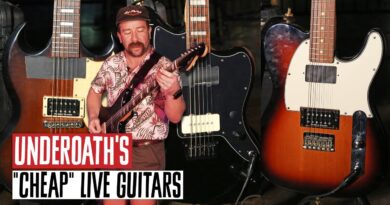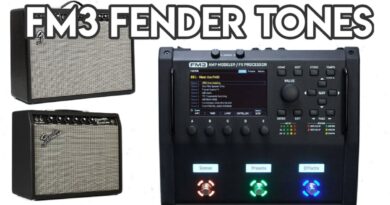Why don’t I use my amp’s FX loop (& what I LOVE to use instead) | Secret Weapons
I never my amps FX loops. Lets talk about why.
Support me on PATREON and get exclusive access to the music in this video, behind the scenes content, and my Discord: https://www.patreon.com/markjohnston
Timecodes:
00:00 Intro
05:46 Into the front of my amp
09:43 Into the amps FX loop
13:24 Setting up my preamp inserts
14:49 Into the preamp insert
Recorded in Universal Audio LUNA
Thank you for watching. If you like what you heard here, consider following me on Instagram for more music, gear, and a look behind the scenes of producing videos like this.
http://instagram.com/markjohnston/
Below is a list of the gear I use to make these videos. They are affiliate links and help support the channel if you purchase anything.
– VIDEO GEAR –
Camera: BMPCC 6K G2 – https://amzn.to/3shcFWd
Lense: Sigma 18-35mm F1.8 Art DC HSM Lens for Canon – https://amzn.to/3DZ2eJw
Light: SmallRig 120B – https://amzn.to/3uJgvsG
Monitor – https://amzn.to/3ljLrZ2
Tripod – https://amzn.to/3mBRzvd
#dont #amps #loop #LOVE #Secret #Weapons
Originally posted by UCrTGtakBzwHfff2aOFXR71g at https://www.youtube.com/watch?v=9KJ9OGXcrVI




Explanation begins at 2:20
My tone got better once i started getting my gain stages from pedals and running everything into the front of the amp. Now I just want a Hiwatt. I just want a loud clean tone to stack pedals on top of
Would love to see how you configure the color box!
I personally run my dirt pedals into tonex one and put wet effects after the preamp and cabsim – that way I avoid overloading the preamp and getting unpleasant, digital distortion
I guess the baby version of your third option is going from a preamp pedal like science mother into an ox stomp and then into wet effects post ox stomp.
so just the opposite, I love to complicate my life. I love running delay and reverb parallel with a Duophony or Line Selector, through the effects loop in parallel on my Bogner Ecstasy 101b, (which can be in series or parallel). I like keeping the guitar fairly dry and intact going into the amp with a 10' cable for recording and setting up the loop as described.
However, it all depends on the context of what is best for the song…
Reverb, delay and compressor options on the Ox works quite well for me… I have a series FX loop on my amp but rarely use it as my delays are usually short slapback and doubling and no or short room reverbs that work well in front of the amp.
I would love a video showing the pros and cons of using a preamp pedal with a power amp to a cabinet over using a preamp pedal in front or to an fx loop. I have a science mother preamp pedal running in front of my hot rod deluxe atm, but I was interested in how it would be with say the lictlaerm Medusa into a 212 or 412. I'm going back and forth of either picking up a science mother 50w head and some sort of cabinet with 2 12s and a 15; or run a dual setup using the hot rod for cleans/modulation and the science mother preamp pedal into power amp and into a cabinet
So mono out ox>into ;pre amp in..pre out to mono pedal in…stereo out to both pre-amp in. If you already used the IN for one of the pre amp….how do you have 2 ins? Also ur thoughts on wa273? Awesome video…ty
Signal path using the Meris inserts sounded amazingly
time to redo my board !
Hey Mark
This video is super timely as I’ve been in somewhat of a battle between deciding whether I wanna go into the front of my amp or into the effect loop of my amp, all for similar reasons that you discussed, in the end, I like them both for different situations totally speaking.
I’m pretty curious what you were alluding to at the end of the video with using wet effects after a preamp specifically for Live rig set ups. I would follow up and say I don’t tend to put any of my guitar through the PA because typically for the type of venues that I play you never know if the sound engineer is going to be any good to be able to deal with that properly, so I think it’s always best to have control on stage.
Anyway, if you have any more info, feel free to lay it on me !
What about placing wet effect after, say, a UA Ruby, for example?
I am a single room at-home project studio owner, who is right at my sweet spot with edge of breakup guitar tone too. I agree with your positions as stated in this video.
I however consider stereo effects an almost must-have condition for my tone. Which is why I almost never use effects in the effects loop (which is almost invariably mono) of any tube amp.
There is one instance where I will use an effect in the mono loop of an amp. I have a silver face drip edge 1968 Bandmaster. I've committed sacrilege. As I write this, I'm having the amp modded to include a serial effects loop. Please don't slam me in the comments. I can always have the mod reversed with zero affect to the amp. But I'll never sell it. It goes to a new buyer after I'm gone.
My Bandmaster has a "Vibrato" channel (which Fender incorrectly named the tremolo effect). But it doesn't have a reverb built in. On Fender amps of the same era that do have reverb built in, the tube driving the spring reverb is placed in the same circuit as the tremolo effect. Which is before the phase inverter and power amp section of the amp. That's where I had my tech put the serial effects loop.
Voila! Instant conversion of a Bandmaster to a Deluxe Reverb. Sort of… the Bandmaster uses more powerful 6L6 tubes for about double the power of a Deluxe Reverb which runs 6V6 power tubes. Personally, I can't hear the difference in edge of breakup tones.
Any way, that's where I put a reverb effect. Even though it's mono, I simply love the sound of the combination of tremolo and reverb in a vintage Fender amp.
There are some solutions to having stereo effects after your amp that you don't mention here.
I'll start with an example you can use to create a W/D configuration using any amp with a serial effects loop. I call this the 'side view' trick because I use my Kemper Profiling Amp to create a 'profile' of the tube amp I am using.
First, I get the tone set to exactly where I want it to be in mono with no effects. Then I create a profile of my tube amp with my Kemper. Of course, you can use a profiler / capture device of your choice.
Now I use a line level splitter to send the output of the tube amp's send jack to a stereo effect or effects. I return the two outputs of the effects, one side to the tube amp's power amp input (the loop return) and the other side to the profiler.
Don't change the settings on the profiler. You want exactly the same tone on the profiling side as the tube amp side. And don't add effects in the profiler. Use whatever cabinet you'd use with your profiler if it was being used in mono (Kemper Kone, Tonex, FRFR, etc).
The next setup is for my favorite configuration: W/D/W. And it involves the solution I hinted above for the Bandmaster's ear-splitting volume. I found this solution by accident because I'm moving to an apartment, don't like totally silent recording (i.e. listening to my tone on headphones), and happen to see other applications for the device.
It's the Fryette PS-2A, which cost me $900, but it is worth every penny. The Power Station's a Swiss army knife that does reactive loading for bedroom level volume while preserving my guitar's tone with a pushed amp. It's also a re-amping box so I can play my Bandmaster with the volume set to 6, yet listen to my matching 2 x 12 Fender cab without disturbing anyone in the next room. And it comes with two line level outputs so that I can do W/D/W in the room and send a line output to my UA Apollo interface to record my dry amp sound. All at the same time. It even has a mono post-amp serial effects loop (which I don't use).
For W/D/W, I use the tube amp into the PS-2A's amp in jack. I use the built in tube amp to re-amp the dry sound though whatever cab I want to use. Then I send a second line output from the PS-2A into my pedal board. The pedal board has lots of stereo effects:
a Fractal VP-4, Source Audio Nemesis, Walrus Audio Mako, etc. That goes to a stereo power amp and a pair of cabs. Sometimes, I use my Mesa 20/20 with stereo cabs; sometimes, I output to a solid state stereo preamp that goes to my studio monitors. I use the second line out to provide a direct recording feed from the dry amp sound. And I split the wet outputs to get them into my Apollos.
The third method uses two mono preamps, configured in stereo and a GFI Duophony to blend them. You can use two stand alone preamps or two preamp sections from an amp with a serial effects loop. Remember the video you did with the Duophony and two UA pedals? That's what inspired me to create this method.
To do W/D/W, I send the two preamps into the Duophony, blend to taste, and return a mono output to my PS-2A through a Fryette Cyclops. I use the PS-2A to the same way I did above. While I could if I wanted to, I just don't normally use a power amp in this configuration. I generally use the 20/20 for the wet outputs here.
Method four: identical stereo preamps into a real stereo power amp.
I have a Mesa Boogie Rectifier Recording Preamplifier. It has a mono input, a mono effect send (on it's parallel effects loop), a stereo return and two pairs of switchable outputs. One pair has a compensated "recoding" stereo output for going direct into your audio interface. The other pair is the "live" stereo outputs, which entirely bypasses Mesa's idea of analog power amp emulation. And provides what is essentially the actual preamp circuitry of a Mesa Dual Rectifier amp.
I bought it new in the early nineties for the "recording" capability, which I, ironically, never used. Because I got a Mesa 20/20 rack amp and a pair of Mesa cabs, running the whole rig in stereo. I used mics to record the real amp sound, which I've always preferred.
Anyway, I'm having my tech turn the parallel loop into a serial loop. Why? So I can slot my pedal board into the effects loop. That will give me a real stereo setup from the preamps through the effects and to the cabs.
I'll be getting the pedal version of the Tone King Imperial MKII when it comes out (maybe in May for around $600). It is an exact replication of the preamp of the aforementioned amp, with full stereo I/O and a stereo serial effects loop. It even has the same attenuation circuit for each channel that's on the amp. I will use it in the same way as I use the Mesa preamp.
The three tube pedal is designed like the Friedman IR pedals. The third tube is for the built in reverb and stereo tremolo circuit. They even have a way to use the pedal strictly as an effect pedal, turning off the two preamp channels. I really am looking forward to hearing the stereo tremolo in the effects loop of my Recto Preamp.
I’m very similar to you, Mark. I used to use FX loops- though I was rarely satisfied with them- so that I could use amp distortion. Over time I moved (mainly) from the amp to gain pedals for my drive tones and yet I do like a little edge from the amps too. I run a Mesa Lone Star and TA30 in stereo with all effects going into the front of both amps. It just works.
30 seconds in and I'm so stoked for this one because I have been looking for solutions to avoid using effects loops for a while lol.
Mark have you tried doing a "TPS Wet Dry"? Running all wet effects into one amp, and all your drives into a 2nd amp. Seems like that would be an easier solution (for live use, outside of a studio setup).
I personally prefer having the loop as I just like how my time based effects sound after the preamp section of my amp. I've also become super nerdy and have been using my FX loop to split the signal, one part going into the effects return of a combo amp I have, getting the full sound of my head, while the other side completes the loop of my amp head and gets plugged into my captor for recording into my DAW. Interestingly, the combo amp I have has an emulated cab out, so I can also route that to have a true stereo recording directly to my DAW which is super nice for my current setup.
Victory Deputy is insane! I love that amp so much and dearly. I don’t use the fx loop either. I’m also a culprit of being lazy lol. I used to but realized idc whether it’s in front of amp or fx loop.
How are you liking your victory so far? It’s kind of just ended my search for an amp. I have a Laney LA Studio and Orange Stamp Box but they don’t get much use anymore because of the Deputy.
I love FX loops in my amps. If it doesn’t have one, I feel like I have no need of it. Maybe that’s just to limit my options, haha.
Edit: I like to throw a chorus before all my dirt pedals. It’s makes it sound real nice and gritty.
I'd love to watch you do a video on Reamping. Using something like the Radial Stereo Reamp box.
Why your solis ventus has the lines "spinning"?
Mark, thank you so much for the impressive detailed explanations! I could never get my wet effects to sound good through my none effects loop imperial II. That pedal show just did an example of splitting the overdrive and ambient pedals into two separate signals (parallel) into front of amp. This seems to help with much better performance. You have added even more to consider…. I’m very grateful for the work you’re doing. I’m gonna try to support w/patreon. Cheers
I feel the same. Thanks for that confirmation from your point of view.
I do use effects loops, because some of my wet effects do not have analog dry through and I want my gain stages and a few analog effects like my thermae to hit the input of my amps with no ad/da conversion. If it were only one time, I could probably get behind it, but it happens at least three times in my chain
I wrestle with this regularly, my chain being drive pedals, UA Woodrow, Jam Delay Llama, UA Starlight, UA Ox Stomp. I usually leave the Starlight in place and move the Llama around.
I love that you are doing more education and instruction videos lately rather than just pedal reviews. The chord video was especially good.